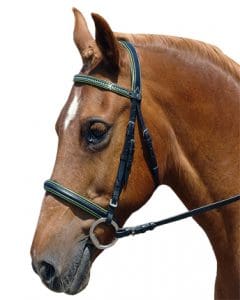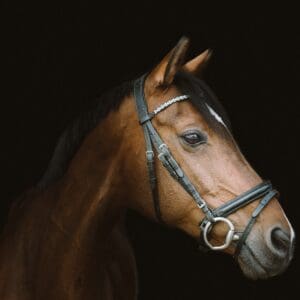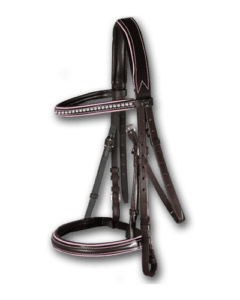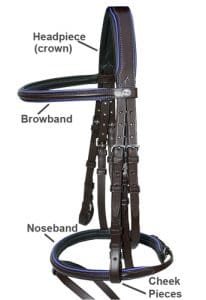**  USA Customers: Enjoy up to $800 Tax Free Imports - Even with Tariffs, we're still better value than US stores! **
USA Customers: Enjoy up to $800 Tax Free Imports - Even with Tariffs, we're still better value than US stores! **
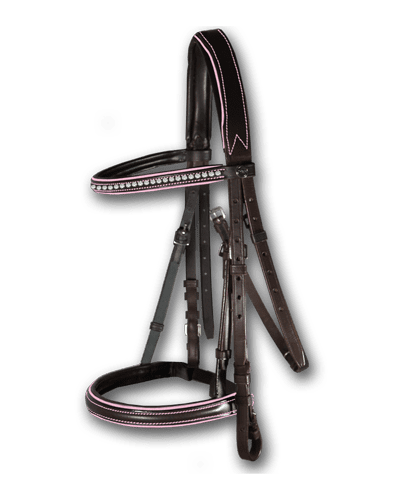
In our latest guide, we’re diving into the wonderful world of bridles. Whether you’re a seasoned rider or just starting out, understanding the different types of bridles available is crucial for a successful ride. From English to Western styles, each bridle has it’s own features and uses.
Join us as we explain the difference between a plain, flash and Weymouth English bridle or a one ear, two ear western bridle, uncovering their unique characteristics and when they’re best suited for your riding needs. So lets saddle up and discover which bridle is the perfect fit for your and your horse or pony.
There are many different types of bridle, but broadly speaking they can be split into two camps, English Bridles and Western Bridles. Simply put English Bridles are used for English riding disciplines and Western Bridles for Western Riding Disciplines. Each type of bridle has been designed with those particular disciplines in mind and that is what we are going to examine next.
An English Bridle normally includes a noseband and a browband and can be used for English disciplines such as dressage, jumping, Eventing, leisure riding or just hacking out. There are three basic types of English Bridle, they are a single bridle, a double bridle, and a bitless bridle.
A single bridle, (also known as a snaffle bridle), incorporates a noseband, a browband, one set of reins, and a horse bit. It is the most common bridle because it is relatively simple to put together, extremely versatile (being used for many different disciplines), and popular with beginner, novice, and experienced riders alike.
Normally a snaffle bridle has a cavesson nose band with or without a flash strap (these are known as English Plain and English Flash, the English flash is also known as a Hanovarian Drop). Some horses have a tendancy to open their mouths, chew or even get their tongue over or behind the bit when being ridden. A flash strap prevents these issues. Below are examples of Pink Equine Snaffle bridles, one plain and one with a flash strap.
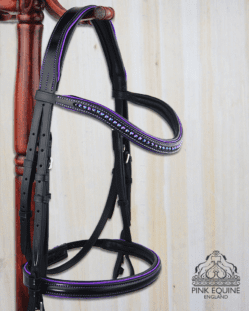
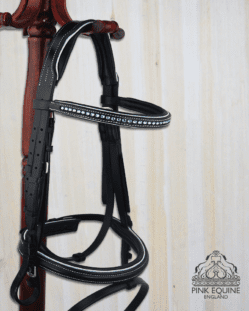
The other slight variation to the single bridle is the Swedish plain bridle and the Swedish Flash bridle (also known as a crank bridle). Similar to the snaffle bridle with the addition of a padded section to the back of the nose band. (this is called the crank noseband).
Snaffle Bridles can accommodate a wide variety of bits, depending on your horse and the control you may need, such as the Snaffle bit, including the Eggbutt, D-ring, french link and loose ring snaffle, the Pelham bit with Copper Link, Rubber Mouth Snaffle, Kimberwick, or a gag bit, to name a few.
As the name suggests, the double bridle or Weymouth bridle has two bits, controlled independently by two sets of reins. It is the only bridle where an additional bit is incorporated and double bridles are most commonly used for dressage. In fact, when competing in dressage competitions at Prix St George level or above, the double bridle is mandatory.
An additional smaller leather headpiece (the slip head) sits directly under the main headpiece and connects a small slim snaffle bit (with bit rings) called a “Bridoon”. The second bit is a “Weymouth bit” (hence the name Weymouth bridle) or now more commonly called a “curb bit”, and is connected to the bridle via the cheek pieces. The curb bit is normally used with a thinner pair of reins known as the curb reins.
Double bridles are normally sold with a cavesson noseband and padded headpieces are also common providing additional comfort to the horse. The Bridoon bit sits above and behind the curb bit, which is the harsher bit of the two as you can see on the image below.
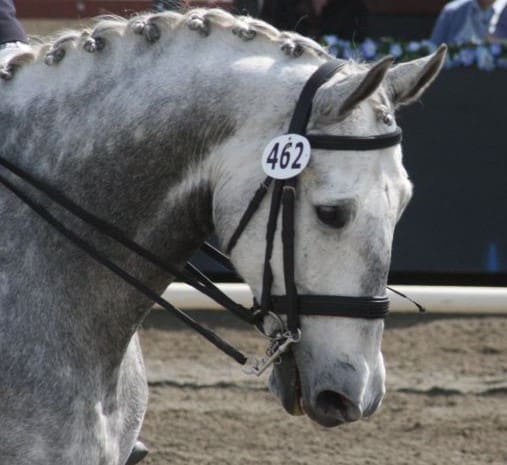
Double bridles allow experienced riders to send much more subtle messages to the horse via the combination of bits, which can result in breathtaking manoeuvres such as pirouette, piaffe, or passage. However, the combination of an inexperienced rider/horse and two bits in the horse’s mouth can lead to catastrophic results and this is the reason why double bridles are normally only used in high-level dressage and showing.
A dressage bridle as the name suggests is one used when riding in dressage competitions. They can be single or double bridles as we have discussed above depending on what level you are riding to.
Dressage bridles are made from black leather and often distinguished by their broader leather construction and comfortable padding with crank-style nosebands. Dressage riders love to embrace the latest trends and many dressage bridles incorporate unique elements such as patent leather, contrasting padding, bling browbands with sparkling rhinestones or ornate metal accents, that add a touch of flair to the riding ensemble. Flash nosebands are a common feature in dressage bridles, primarily aimed at securing loose ring bits in the horse’s mouth during maneuvers. An example of a Pink Equine dressage bridle is shown below.
The grackle bridle or “Figure 8” is a snaffle bridle with a noseband that crosses over from one side of the horse’s cheek to the chin on the other side in a figure 8 pattern (hence the name Figure 8 bridle).
The Grackle noseband keeps the horse’s mouth closed, whilst enabling the nostrils to flare allowing more airflow through the nose. The crossover part of the grackle is normally padded with sheepskin for comfort. Grackle bridles are commonly used in show jumping, polo, and the cross country phase of Eventing competitions. Example of Pink Equine grackle bridles below.
As the name suggests, a bitless bridle is a bridle that doesn’t rely on a bit to control the horse. Instead, control comes from a special type of noseband, that applies pressure to the nose and chin area of the horse’s face.
A Hackamore bridle is another version of a bitless bridle. The Hackamore consists of a noseband called a Bosal, which is connected to a shank on either side of the horse’s mouth (similar to a bit but not sitting in the horse’s mouth). Although there is no bit, it is still possible to apply a lot of pressure, and the longer the shank the greater the pressure that will be applied.
Bitless bridles are gaining in popularity, but the argument that a bitless bridle is gentler on a horse than a conventional bridle is not necessarily true. Some horses do not like pressure on the nose or poll area (which is how a bitless bridle provides the control). It depends very much on an individual horse or pony and as always the use of any equipment is only as good or bad as the person using it. Bitless bridles are not allowed in Dressage or the cross country phase of Eventing competitions.
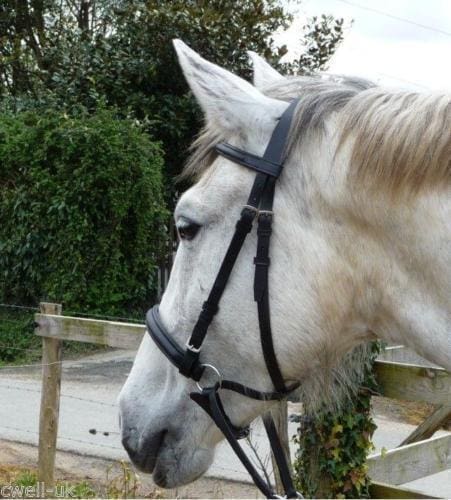
A pelham bridle uses a pelham bit which includes components of a curb bit and a snaffle bit. It is used to replace a double bridle where the rider wants the control from double reins but not two separate bits.
Pelham bridles are popular on polo horses, where the control of a double bridle is required, but the rider has limited ability to make rein refinements. Polo bridles commonly include a wide flat leather noseband with no padding.
Pelham bridles can also be useful in aiding the transition from single bridle to double bridle. An example of a pelham bit below.
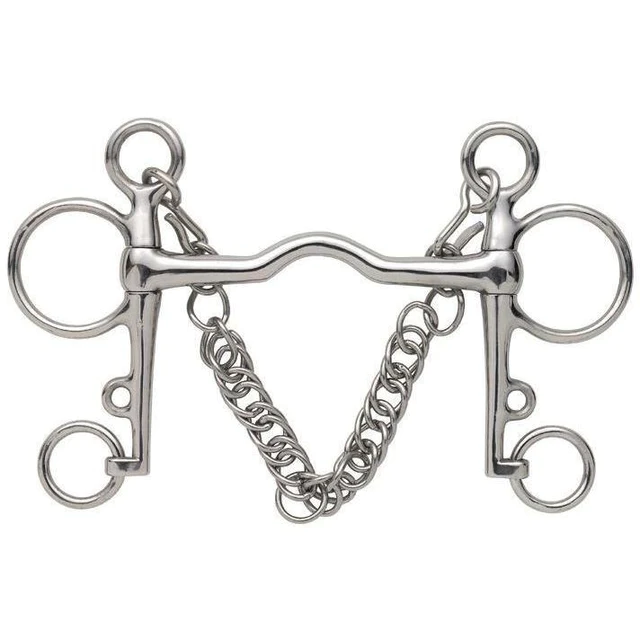
An ergonomic bridle or anatomical bridle is a bridle that has been designed with the horse’s anatomy in mind and follows the contours of a horse’s head, helping to reduce pressure on the facial nerves. You will find parts of the bridle have been cut away or more padding added to ensure a greater range of movement and reduction of pressure ensuring maximum comfort for your horse.
Ergonomic bridles are very popular. You will find a bewildering array of different shapes and styles, all claiming to provide the horse with the ultimate comfort. They also tend to come with a heavy price tag. Example of Pink Equine ergonomic bridles.
Western bridles are designed to be lightweight, simple, and comfortable for the horse working over long distances. They differ from English bridles in that they do not have a noseband and in many cases no traditional browband. Western riders, use looser reins controlling the horse with the reins held in one hand, the rider using their, weight and neck reining to communicate to the horse. This compares with the English way of using both hands independently to give instructions to the horse.
Western bridles are used in all Western disciplines such as trail riding, rodeos, reining, and by cattle ranchers and cowboys. Western reins are much longer than their English counterparts and are split at the ends. Western Bridles can be made from leather or synthetic materials, consisting of a headstall, two cheekpieces, a single bit(a simple snaffle or curb bit is used), and a set of reins. There are three types of Western bridle, the working bridle, the one-ear bridle, and the two-ear bridle.
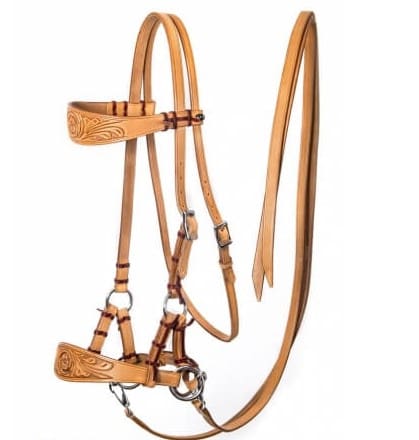
The working bridle is typically a very basic bridle with no frills or decoration, consisting of a browband, headstall, and bit. Used for everyday riding, the throat-latch keeps the bridle in position and uses a curb bit.
As the name suggests, rather than a browband the headstall has a loop of leather (or the headstall leather is split) that sits over one of the horse’s ears. This is useful if the horse does not like a straight-across browband.
Similar to a one-ear bridle but there are two independent loops of leather that sit over each ear. Two ear bridles lack a throatlatch and tend to be reserved for showing in the ring.
Whilst western bridles are most popular in the US, there is a growing movement in the UK and many clubs and associations that promote “Western riding”. Bridles vary widely in price, from simple functional bridles to highly decorated show bridles. Examples of a one ear and two ear bridle below.
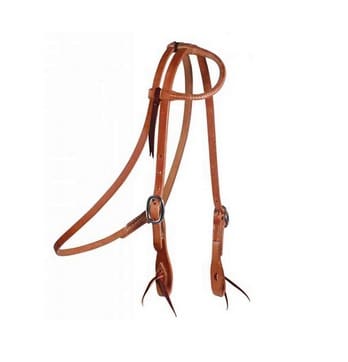
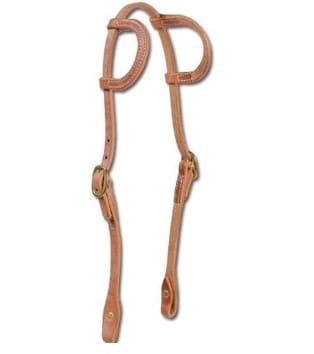
Now you have seen the types of bridles available, here are a few thoughts on what you should consider when choosing a bridle for your horse or pony.
The first area is “Comfort”. Choose the right size, one that fits correctly and is as comfortable as possible for the horse. Familiarize yourself with the parts of a bridle and how to measure for a bridle, so you have an idea of the size you will need. For example, if you have a horse with a sensitive poll area, you may require a shaped headpiece with additional padding. Different types of noseband such as drop noseband may also be considered if your horse is sensitive around the nose area.
The second area is “Control”. Make sure that the bridle will allow you safe control of your horse. For example, if you have a horse that is “mouthy” and inclined to play with the bit, you may want to incorporate a flash noseband to ensure your horse doesn’t get his tongue over the bit and lose control of the horse. Also important in terms of control is the horse bit. Contact from the reins applies pressure through the bit to the horse’s mouth. There are many different types of bit and each applies pressure to one or more different parts of the mouth, depending on the type of bit you choose.
The third area is “Rule compliance”. If you are riding your horse in a particular discipline and intend on competing, you should make sure that your bridle is on the list of acceptable horse tack. For example in Affiliated Dressage, horse bridles, may be cavesson, dropped, flash, or grackle, or a combination nose band that doesn’t require a throat lash.
Bridles can be black bridles, brown bridles, grey, or navy and can have any colour piping/bling. Additional padding is only permitted on the underside of the nose band (the part that does up under the chin) Double bridles are only permitted from Elementary levels and above. If competing at an international level, a double bridle must be worn for Prix St George and above. Even if you are not planning to compete, it is sensible to use a bridle that is suited to the specific discipline.
The fourth area is “Aesthetics”. You wouldn’t put a narrow leather bridle on a shire horse, because it would look ridiculous. Similarly, a horse with a wide forehead may look better in a wave browband to accentuate its features. If you are showing or participating in certain competitions, then an attractive-looking bridle can help make your horse stand out from the crowd.
Understanding the different types of bridles available is essential for riders seeking optimal performance and comfort for their equine partners. Whether you ride English or Western, each type of bridle offers its own set of advantages and considerations. At Pink Equine, we’ve been making and designing premium horse bridles and tack since 2007, with a commitment to customisation and quality. Our custom-made bridles allow riders to mix and match parts for a perfect fit, ensuring every horse receives personalised attention.
Feel free to explore our ranges of top-quality horse bridles to elevate your riding experience and join our free Pink Equine club where membership entitles you to enjoy valuable help, tips and knowledge, access to free competitions, new ranges and exclusive member discounts.
For more information on horse bridles please view the articles below.
